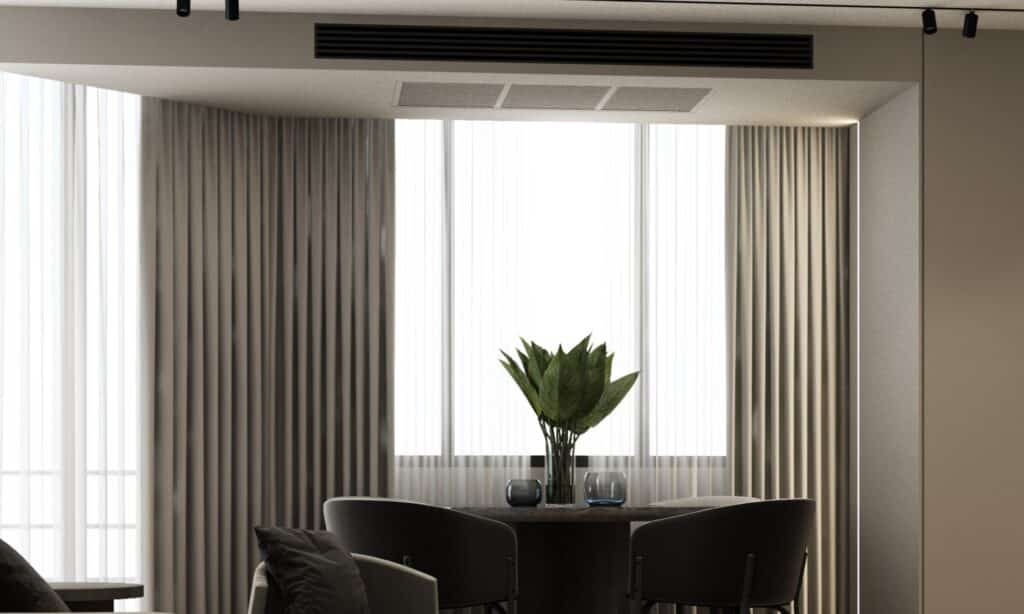
The Role of Insulated Blinds in HVAC Efficiency
Insulated blinds can prevent up to 30% of indoor heat loss, easing the burden on HVAC systems and curbing energy expenses. Their air-trapping designs reduce heat transfer effectively, keeping homes warm in winter and cool in summer. This improves HVAC efficiency, cuts utility costs, and supports sustainable living by enhancing overall energy conservation.
Understanding Insulated Blinds
Insulated blinds are more than just a stylish window covering; they are a strategic investment in home energy efficiency. With heat loss through windows accounting for up to 30% of energy waste, homeowners face unnecessary HVAC strain and inflated utility bills. The solution lies in innovative blinds that incorporate air-trapping designs, forming a crucial barrier against temperature fluctuations.
Cellular shades, known for their honeycomb structure, excel at insulation due to their unique design that traps air within individual cells. This air serves as an insulator, reducing the transfer of heat between the window and the interior, which significantly enhances their R-value or resistance to thermal flow. For those seeking a blend of functionality and aesthetics, Roman shades with added thermal lining offer excellent insulation while maintaining a classic look.
The benefits of insulated blinds go beyond energy savings. They contribute to quieter, more serene spaces by reducing outside noise and protecting interiors from UV rays, which can fade and damage furnishings. This added layer of defense extends the life of home décor and maintains indoor comfort year-round.
By adopting insulated blinds, homeowners not only reduce energy bills and HVAC load but also make a step toward more sustainable, eco-friendly living. This modern solution is a testament to how thoughtful design can meet practical needs, ensuring both comfort and cost savings.
Types of Insulated Blinds
Maximizing energy efficiency and maintaining a comfortable indoor environment starts with smart window treatment choices. Insulated blinds are one of the most effective solutions for reducing heat transfer, thereby easing the strain on HVAC systems. By creating a thermal barrier, these blinds help maintain a steady indoor temperature and significantly cut energy costs.
-
Cellular Shades (Honeycomb Shades)
Cellular shades are a top choice for insulation due to their honeycomb structure, which traps air in pockets. This design enhances their R-value, making them highly effective in preventing heat loss in winter and heat gain in summer. Available in single, double, and triple-cell varieties, cellular shades can be tailored to meet varying insulation needs.
-
Roman Shades
Roman shades add a touch of elegance while offering notable insulation. Crafted from thick fabrics that can be lined with thermal or blackout materials, they create a barrier that helps regulate indoor temperatures. Though not as efficient as cellular shades, they strike a balance between style and functional insulation.
-
Thermal Roller Shades
For homeowners seeking a minimalist design, thermal roller shades provide an ideal solution. Enhanced with thermal backing, these shades help block heat transfer, maintaining a comfortable indoor temperature and reducing HVAC load.
-
Dual-Layer Blinds
Dual-layer blinds incorporate sheer and opaque sections, allowing for both light control and insulation. The opaque layer serves as a thermal barrier, making these blinds versatile for day-to-night use while preserving energy.
-
Thermal Curtains as Complements
Pairing insulated blinds with thermal curtains can amplify their insulating power. Made from dense, multi-layered fabrics, thermal curtains add an extra layer of defense against drafts and heat loss, particularly beneficial for large or older windows.
Choosing the right type of insulated blinds depends on your home’s unique needs and style preferences. Cellular shades are the top performers for insulation, while Roman shades provide style with decent thermal efficiency.
Thermal roller shades are perfect for a modern look, and dual-layer blinds offer versatile light and temperature control. Combine these with thermal curtains for maximum energy savings and comfort, reinforcing a commitment to eco-friendly living.
How Insulated Blinds Enhance HVAC Efficiency
Insulated blinds play a significant role in enhancing HVAC efficiency by reducing the energy load required to maintain comfortable indoor temperatures. These specialized window treatments use innovative designs to create a thermal barrier between the window surface and the room. This barrier minimizes heat transfer, helping to keep warm air inside during winter and blocking heat during summer.
Key Ways Insulated Blinds Improve HVAC Efficiency
Reduced Heat Loss and Gain
Insulated blinds effectively trap air within their structure, acting as a buffer that slows down heat transfer. In winter, this means less heat escapes through the windows, maintaining a warmer indoor environment without excessive reliance on heating systems. During summer, these blinds prevent heat from entering the home, allowing air conditioning to operate more efficiently.
Decreased HVAC Workload
By stabilizing indoor temperatures, insulated blinds lower the frequency and intensity at which HVAC systems need to run. This reduced workload not only saves energy but also prolongs the lifespan of HVAC equipment, minimizing the need for maintenance and repairs.
Improved R-Value
The R-value of a material indicates its capacity to resist heat flow. Insulated blinds, especially cellular shades, enhance a window’s R-value by incorporating multiple layers of air pockets that act as insulation. This increase in thermal resistance helps maintain consistent temperatures and reduces energy consumption.
Energy Cost Savings
Homeowners can benefit financially from installing insulated blinds, as improved HVAC efficiency directly translates to lower utility bills. With less energy required to heat or cool a home, overall energy expenditures decrease, making insulated blinds a cost-effective investment.
Installing insulated blinds contributes to a more energy-efficient home by supporting HVAC systems in maintaining stable temperatures. They reduce heat transfer, decrease HVAC strain, and lead to significant energy cost savings all while promoting a more sustainable approach to indoor climate management.
Benefits Beyond Energy Efficiency
Beyond their energy-saving capabilities, advanced window treatments like insulated blinds offer several additional benefits that enrich the overall living experience. These blinds are not just functional—they elevate comfort, privacy, and protection within the home.
Enhanced Noise Reduction
The multi-layered structure of cellular and dual-layer blinds significantly reduces outdoor noise. The design traps air within individual cells or between layers, creating a sound-absorbing barrier that dampens outside sounds. This feature is perfect for homes near high-traffic areas, providing a peaceful and more serene indoor space.
Protection from Harmful UV Rays
Prolonged exposure to direct sunlight can fade and weaken furniture, flooring, and decor. Insulated blinds block a significant amount of UV radiation, safeguarding these elements from premature damage. By filtering out harsh sunlight, these blinds maintain the look and longevity of interior furnishings.
Greater Privacy and Security
These window treatments provide excellent privacy due to their denser construction compared to traditional blinds. Whether in living rooms, bedrooms, or bathrooms, the added opacity ensures a greater sense of security by preventing unwanted visibility from outside. This privacy adds comfort and peace of mind to daily living.
Year-Round Comfort
Insulated blinds effectively regulate room temperatures, keeping interiors cooler in summer and warmer in winter. This temperature stability means fewer adjustments to the thermostat, resulting in consistent comfort and lower energy use. It is an effortless way to maintain a comfortable atmosphere throughout the year.
Aesthetic Adaptability
With a wide range of styles, materials, and colors available, insulated blinds can match any home decor while delivering practical benefits. Whether you prefer the sleek look of roller shades or the classic appeal of Roman blinds, there is an option that suits both aesthetic desires and functional needs.
The advantages of insulated blinds extend well beyond their primary function of energy efficiency. From reducing noise and blocking UV rays to ensuring privacy and consistent temperature, these window treatments enhance the overall quality of life. Their versatility in design also means homeowners don’t have to choose between practicality and beauty, making them an excellent long-term investment.

Automation and Modern Features
Modern insulated blinds now incorporate cutting-edge automation features, enhancing both their practicality and efficiency. These technological advancements align with smart living, offering homeowners superior control over temperature regulation and energy management.
Automated Timers for Energy Savings
Automated blinds can be programmed to open and close at specific times of the day, optimizing natural light use and reducing HVAC load. This ensures that blinds block out intense sunlight during peak hours to keep interiors cool, or open during the day in colder months to allow in warming sunlight. Such strategic use of daylight significantly curtails energy consumption and costs.
Seamless Smart Home Integration
Insulated blinds can now be integrated with popular smart home systems such as Amazon Alexa, Google Home, and Apple HomeKit. This allows for control via voice commands or mobile apps, making adjustments simple and seamless. Connecting blinds with smart thermostats or sensors enables coordinated actions—like closing blinds when indoor temperatures hit a set threshold—to optimize overall home energy use.
Temperature and Light Sensors
High-tech models include built-in sensors that detect changes in temperature and sunlight. These sensors automatically adjust the blinds, providing hands-free, real-time energy management. For example, they close when intense sunlight increases indoor heat or open to allow passive solar warming during cooler periods.
Customizable Scheduling and Security
Custom schedules can be created to match daily routines, ensuring that blinds are consistently managed for maximum energy efficiency. This automation also doubles as a security measure, simulating occupancy when homeowners are away by randomly moving the blinds, which can deter potential intruders.
Remote Operation for Convenience
Insulated blinds equipped with remote or app-based control provide an effortless way to manage windows from any location, perfect for large homes or hard-to-reach windows. This feature is especially beneficial when adjusting blinds for optimal energy use during unexpected weather changes.
The fusion of insulated blinds with modern automation not only enhances comfort but also supports a more energy-efficient home. Features like smart scheduling, responsive sensors, and integration with existing smart home systems ensure that temperature control and convenience are at homeowners’ fingertips. This blend of technology and functionality makes automated insulated blinds an innovative choice for those looking to maximize energy savings and simplify home management.
Comparing Insulated Blinds to Other Solutions
When choosing window treatments, it is essential to weigh their impact on comfort, energy efficiency, and aesthetics. Insulated blinds stand out compared to options like traditional blinds, curtains, and smart window films.
Unmatched Energy Efficiency
Insulated blinds feature a honeycomb structure that traps air, creating a barrier against heat loss in winter and heat gain in summer. This leads to substantial energy savings and improved HVAC performance. Traditional blinds can control light but do not provide significant insulation. Curtains, particularly heavy, thermal ones, offer some insulation but can not match the consistent efficiency of insulated blinds. Smart films block UV rays and reduce glare but lack the thermal control of cellular blinds.
Versatile Style Options
With an array of colors and styles, insulated blinds seamlessly integrate into any home’s décor. They provide a sleek, modern appearance, unlike bulkier curtains. Traditional blinds come in various finishes but lack the insulating function of insulated blinds. Smart films cater to minimalistic tastes but do not offer a visual focal point.
Cost and Value
Insulated blinds offer long-term energy savings at a moderate price point. While traditional blinds and curtains might be cheaper initially, they do not deliver comparable energy efficiency. Smart films have higher upfront costs but limited insulation capabilities, making insulated blinds a smart investment.
Easy Maintenance and Installation
Insulated blinds are easy to install and maintain, needing just occasional dusting to stay in top shape. Traditional blinds share this simplicity but fall short on energy benefits. Curtains require more upkeep, and smart films need professional installation and adjustments.
For homeowners in Farmers Branch, TX, insulated blinds present the ideal solution for comfort, efficiency, and style.
Installation Considerations
Proper installation of window treatments is essential to optimize their effectiveness. For insulated blinds, ensuring a secure and precise fit can greatly enhance their insulating properties and long-term benefits.
Accurate Measurement for Optimal Fit
A precise fit is essential for insulated blinds to function efficiently. Poorly fitted blinds create gaps that allow air to pass through, reducing their thermal effectiveness. The choice between inside and outside mounts can affect the look and insulation: inside mounts provide a sleek finish, while outside mounts offer more coverage and enhanced insulation.
Choosing the Right Mounting Method
Window structure plays a significant role in determining the appropriate mounting type. Inside mounts require sufficient window depth for a tight, flush appearance, while outside mounts can cover a wider area for greater insulation and light control. The method chosen impacts the visual and practical performance of the blinds.
Material Considerations for Stability
Blinds made from heavier or multi-layered materials require strong mounting hardware. Proper support ensures they stay secure and maintain their insulating properties without sagging over time. This approach protects the blinds’ efficiency and extends their lifespan.
Focusing on accurate measurement, suitable mounting options, and secure installation ensures that insulated blinds deliver maximum insulation and energy savings. Attention to these details enhances the overall comfort and efficiency of your home.

Seasonal Adjustments and Tips
Adjusting insulated blinds seasonally can significantly improve energy efficiency and indoor comfort. Strategic use throughout the year helps maximize their benefits and supports a more balanced living environment.
Retaining Heat in Winter
During winter, closing blinds at night creates an insulating layer that helps retain indoor warmth and block out cold drafts. Blinds like cellular shades excel due to their honeycomb design, which traps air and acts as a barrier. During daylight hours, opening the blinds lets natural sunlight warm the space, reducing heating system reliance and cutting energy costs.
Reducing Summer Heat
In the hot summer months, closing blinds during peak sunlight hours prevents excess heat from entering the home. This simple adjustment keeps rooms cooler and reduces the workload on air conditioning systems. Selecting blinds with light-reflective or thermal backing further enhances their ability to deflect heat and minimize energy consumption.
Spring and Fall Versatility
Spring and fall often bring temperature swings that require flexible blind use. Open blinds on cooler mornings to let in warming sunlight, then close them in the afternoon when temperatures rise. This method helps maintain consistent indoor temperatures without overworking the HVAC system.
Automating for Precision
Automated blinds simplify seasonal changes by adjusting to light or temperature sensors. This automated response ensures blinds optimize energy use without manual effort, maintaining a comfortable home environment with minimal intervention.
Layering for Extreme Conditions
For homes in regions with extreme temperatures, combining insulated blinds with thermal curtains adds an extra layer of protection. This combination creates a robust barrier that keeps indoor temperatures stable, enhancing comfort and reducing energy use even during the harshest weather.
Seasonal adjustments to insulated blinds are a straightforward way to boost their performance. Whether by trapping heat in winter, reflecting sunlight in summer, or using automation for effortless changes, these practices ensure year-round energy savings and comfort.
Insulated blinds significantly enhance HVAC efficiency, reduce energy costs, and improve comfort. Contact One Hour Air Conditioning & Heating of Dallas today to learn more.
FAQs
-
Are insulated blinds a cost-effective investment?
Yes, insulated blinds are cost-effective over time. While the initial cost varies based on type and customization, they lower energy expenses by retaining indoor heat in winter and blocking heat gain in summer. Homeowners often see a return on investment through reduced heating and cooling bills.
-
What type of insulated blind works best in cold climates?
Cellular shades, especially double or triple-cell varieties, are ideal for cold climates. Their honeycomb design traps air in pockets, creating effective insulation that helps maintain indoor warmth and reduce heating need.
-
Which blinds are best for hot climates?
In hot climates, choose blinds with reflective or light-colored backing. Cellular shades with reflective coatings and dual-layer blinds minimize heat gain, keeping rooms cooler and cutting air conditioning costs.
-
How should insulated blinds be maintained?
Maintenance is simple: regular dusting or vacuuming with a brush attachment suffices. For deeper cleaning, use a damp cloth. Automated blinds may need occasional checks to ensure motors work well.
-
Are insulated blinds effective year-round?
Yes, they retain heat in winter and reduce solar gain in summer, making them efficient in all seasons. Automated versions can adjust based on daylight and temperature for continuous energy savings.







